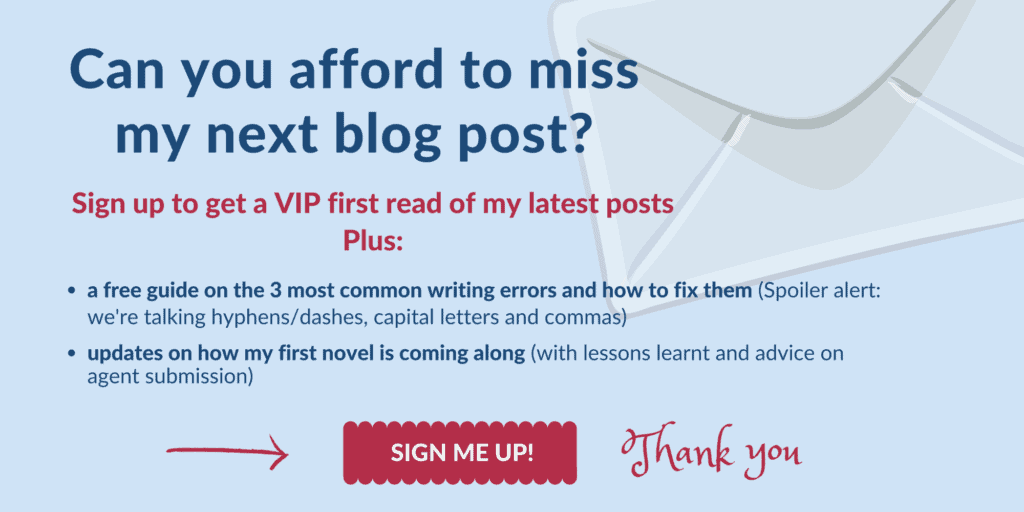
You’ve received beta reader feedback on your manuscript. Now what? Find out how to organise and act on it.
I sent out the current draft of my book to my beta readers a few months back. Some wanted a paper copy, so I created this using Amazon KDP (see my step-by-step guide with video of result), others preferred a digital copy (I used the Compile function in Scrivener). I’ve been slowly but surely incorporating their feedback into my book.
So, you’ve chosen your beta readers and bravely sent them your precious manuscript. After a few nail-biting weeks, they’ve sent back their comments.
Here’s what to do next.
1. Pat yourself on the back
Finishing this draft of your manuscript, one that you’re ready to share with people, is a massive step. Actually sharing it with other humans, especially if it’s your first book, is an even bigger one. Congratulations!
2. Don’t get drawn in too early
It’s natural to want to read each beta reader questionnaire as it comes in, and get drawn into a particular piece of feedback. However, if you can, wait until the feedback comes in from all your beta readers before reading a single word.
I know, I know, seems impossible, right? (I have to admit, I did sneak a few peeks.)
But think about it. If the first beta reader to return their feedback wasn’t keen on your book, but the second person loved it, aren’t you better off waiting until you can console yourself with some positive feedback right after reading something more negative?
Plus, remember that just because one person doesn’t like the way you’ve done something, it doesn’t mean the world will hate it. More about that in a bit.
3. Organise your beta reader feedback
Create a folder wherever you store your files, and call it something logical like ‘Beta readers’. As your beta reader feedback comes in, store it in this folder so you have everything in one place, ready for when you need to act on it.
Rather than dealing with one beta reader at a time and working through their lengthy comments, or their questionnaire responses, take time to compile the feedback into a spreadsheet. This will help you to edit more efficiently, as you can:
- attack all the typos and small errors chapter by chapter
- work out the best order in which to make changes (one may impact another)
- see if most beta readers found a particular scene slow, or if it was just one person
- determine how much work you need to do
To save you some time, here’s a beta reader feedback template that I made earlier, for you to use as you want (no watermark!):
You can add your own items to the drop-down lists by editing the ‘Drop downs’ worksheet. Any queries or issues, just let me know in the comments or contact me.
Top tip to protect your sanity: Log positive comments as well. I’ve included a separate worksheet in the spreadsheet template where you can store all these, and refer back to them as often as you need to.
If you find the template useful, please consider a little thank-you in the way of a small Kofi donation to keep my site running so I can keep providing free resources. Even one pound/dollar will be welcomed!
4. Decide what feedback to heed … and what to ignore
Your beta readers have generously given their time and effort in providing you with their comments. Of course, you’re very grateful, but remember you don’t have to act on every piece of feedback.
Before we look at how to decide what feedback to act on, bear in mind there are two kinds of feedback: objective and subjective.
Objective feedback
Objective feedback points out something that is a ‘truth’; it can be verified. For example:
- “There’s a grammar mistake on page 4: ‘I lied down on the bed.’ ” (If you want to know why this is wrong, check out my blog post on Lay vs. Lie. There’s a quiz too!)
- “In Chapter 1, Max’s hair is blond; in Chapter 7, it’s black.”
Somehow, these kinds of errors are easier to take on the chin and feel ok about than subjective feedback.
Some objective comments are easily fixed, others may need a bit of unpicking, especially if an eagle-eyed beta reader has spotted a glaring plot hole that affects several chapters or your main story thread. Still, better that it’s spotted at this stage than when your book is subjected to the vultures on Amazon.
Better that errors are spotted at this stage than when your book is subjected to the vultures on Amazon. Beta reader feedback – how to deal with it (with free template) Share on XSubjective feedback
These are comments that come from a reader’s personal viewpoint; they are not objective truths. They can be positive as well as negative, but it will be the negative ones that you’ll probably take more to heart. For example:
- “Why is she so mean? I think you should make her nicer.”
- “This scene didn’t grab me as much as the rest of the book.”
These comments can be harder to deal with, both practically and mentally/emotionally. Remember: if a minority of beta readers have expressed the same issue, you can choose to ignore it (unless it rings alarm bells for you). Yes, you have the power!
How to decide what beta reader feedback to accept
So, you’ve got all your beta readers’ comments organised in your spreadsheet. Time to work through each row and decide what to act on and what to ignore.
Bear in mind the following:
- You’ll need to act on most objective feedback (errors in grammar, spelling, punctuation, plot holes etc), unless you know for a fact they’ve got it wrong.
- If most beta readers (e.g. 3 out of 5 or more) have expressed a negative opinion about something (pacing, characterisation, flow etc), seriously consider making alterations.
- If a minority of beta readers (e.g. 2 out of 5 or fewer) have made a negative comment, decide on which side of the fence you sit. If you agree with what they’ve said, it’s a no-brainer: change it. You may not be sure if you agree, so consider asking someone else’s opinion. If you disagree with their comment, mark it as ‘No action required’. Before you do so, however, carefully consider whether this is in fact your opinion, or whether you’re put out because they’ve criticised your favourite scene. This can be a tough call to make!

5. Make a plan of action
This doesn’t have to be detailed, but it’s worth looking at your completed spreadsheet and deciding in what order to act on the feedback. There isn’t really a hard and fast rule, although it may be worth deciding if you’re going to delete a whole scene before spending time correcting typos in it.
For my book, I decided to work from the micro to the macro (I’m not saying this is the right way, but it was the easiest way for me to wrap my brain around my to-do list, and to give myself time to mull over the larger changes).
My plan was as follows:
- Correct typos and other easy fixes. Quick wins.
- Work on changes that only affect one chapter or one scene, or one character.
- Take time to chew over ‘bigger’ feedback, e.g. deciding whether to remove the first two chapters (yikes!) to make the story stronger, then put time aside to incorporate the relevant changes.
6. Start making changes
Crunch time! It may take longer than you think to act on all the beta feedback. I found that to begin with, I made rapid progress, then slowed right down.
This was partly because I began with smaller changes, some of which only took a few seconds to make. It was also because any project starts off with momentum, then the long tail hits and it drags on, while you (…all right, I) procrastinate and choose to do anything else other than decide how to make that fiddly change to scene 56 that needs to be made but I don’t know how to begin. You get the picture.
A couple of my beta readers suggested removing, or vastly reducing, the first two chapters, as they served mostly as backstory. I’d carefully constructed these scenes and was reluctant to consider the possibility at first.
I took a couple of weeks to think about it, and often my subconscious was mulling it over before I went to sleep, on walks etc. I realised they were right, so I rewrote the start of my book. Painful, but necessary.
To avoid allowing the process to drag out, try to allocate a fixed time each day or each week to work on the feedback. If you have big decisions to make (are you going to delete the first two scenes?), step away from your computer and go on a walk, do some gardening, have a shower or a bath; anything to take your conscious mind off your book and let your subconscious do the mulling.
If you have big decisions to make, step away from your computer and go on a walk, do some gardening, have a shower or bath. Beta reader feedback – how to deal with it (with free template) Share on XRemember to check off each item of feedback on your spreadsheet as you work through it. I’ve set the sheet to automatically turn each row green as it is marked ‘Done’, so you’ll hopefully get a buzz from watching the sheet gradually turn greener!
If you haven’t yet downloaded a copy of my beta reader template, here it is again:
7. Next steps
This will depend on various factors, including the nature of the changes you’ve made, whether you intend to self-publish or traditionally publish, and more.
If you’ve had to make extensive structural changes, you may want to go for another round of beta readers. It’s up to you if you use the same crew to test specific scenes that you’ve altered based on their comments, or if you’d rather get some fresh eyes on your work.
If you’re happy with your manuscript once you’ve incorporated your beta reader feedback, it’s time to hire an editor. Find out which kind of editor you need. If you don’t yet have an editor lined up, I offer line editing and copyediting services. Drop me a line to find out how I can help!
As for me, my next steps are to shorten my book somewhat. It’s currently at 123K words, which is too long for a first novel in the mystery genre going down a traditional publishing route, as I plan to. I’ve already reduced it by 6K words (it was 129K!), so over the next few weeks, I’ll be tightening and reducing further, and aim to get it down to around the 100K-word mark.
You may find it helpful to check out my other two blog articles in this series about beta readers:
Let me know in the comments what your beta readers thought about your work. Also, feel free to drop me a line if you found the beta reader feedback template useful!
Disclosure: Some of the links on this page are affiliate links. This means, at zero cost to you, I will earn an affiliate commission if you click on the link and finalise a purchase. This helps me to keep this website running. I only recommend products and services that I trust and am comfortable endorsing. Find out more.









Leave a Reply